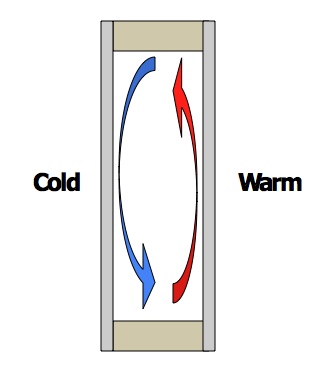Getting Loopy – How Homes without Insulation Lose Heat

You may have heard somewhere that insulation works by trapping air. ‘Dead air pockets’ is the operative term often used. So, the logical next question, then, is, why doesn’t the large dead air pocket in an uninsulated wall cavity reduce heat flow as well? Having spent several years of my life living in older houses that had no wall insulation, I can confirm for you from personal experience that uninsulated walls really do transfer more heat, not less.
One answer lies in the size of the dead air pocket and has a good, sciency name attached to it – convective loops. If you’re thinking about your middle school science class and the three forms of heat transfer – conduction, convection, and radiation – you’re on the right track here. Although radiation is the dominant form of heat transfer in an uninsulated wall, convection, as illustrated below, is also important.
In an uninsulated wall cavity, the air moves in a cycle around the cavity. Starting with air near the bottom that’s been cooled by the cold side of the wall, the air warms up from its contact with the warm side of the wall. Warm air is less dense, so it starts rising in the cavity. As it rises, it picks up even more heat from the warm side.
When the warmed air hits the top of the cavity, it starts collecting there. Some of it moves over and is in contact with the cold side of the wall. Following Homer Simpson’s command (“In this house, we obey the laws of thermodynamics”), heat moves from warmer bodies to cooler bodies. That’s the second law of thermodynamics.
So, the heat picked up from the warm surface now gets lost to the cold surface. As the air cools, it gets heavier again and starts falling, losing more heat along the way. At the bottom, it pools and eventually finds the warm surface again, where the cycle is renewed.
When you put insulation in that wall, you break the convective loop process, and then radiation and conduction are responsible for most of the heat transfer, but radiation is reduced, too. The net effect is that a lot less heat flows from the warm side to the cold side, and the house stays more comfortable.
There you have it. With dead air pockets, size matters – and smaller is better.
Allison A. Bailes III, PhD is a speaker, writer, building science consultant, and the founder of Energy Vanguard in Decatur, Georgia. He has a doctorate in physics and writes the Energy Vanguard Blog. He also has a book on building science coming out in the summer of 2022. You can follow him on Twitter at @EnergyVanguard.
This Post Has 8 Comments
Comments are closed.

Allison, is solid wood (just
Allison, is solid wood (just by itself, not in any particular configuration) a relatively good or poor conductor of heat? Does it have a known R-value?
John, solid wood would be
John, solid wood would be better than an empty cavity because you eliminate the convective loops. It’s worse than insulating materials, however. If you put insulation that gives you R-13 into a 2×4 wall (3.5″ cavity depth), the R-value per inch is about 3.7. Wood has an R-value per inch of about 1.1.
Thats is a very informative
Thats is a very informative piece.Easy to understand yet hits the science of convective looping and dead air space in uninsulated walls. Thank you Allison
You’re welcome, Joseph. Glad
You’re welcome, Joseph. Glad you found it useful.
I thought that compressing
I thought that compressing more insulation (R-19 2 x 6 wall insulation into a R-13 (2 x 4) insulation did not improve and possibly reduced the insulation effectiveness due to compressing the air pockets. Is this true?
Paul, you’re correct. A high
Paul, you’re correct. A high-density fiberglass batt is NOT the same thing as a compressed batt. The difference lies in the size and shape of the dead air pockets.
Paul, let me add to my
Paul, let me add to my earlier reply. If you put a 6″ R-19 batt in a 3.5″ cavity, you’ll get more than the standard 3.5″ R-13 batt, but less than the full R-19. More fiberglass means more insulating value. For a given batt, though, compression reduces the overall R-value. If you take that 6″ R-19 batt, for example, and put in a closed 2×6 wall, which is 5.5″ deep, you end up with about R-18.
On geting loopy,I am
On geting loopy,I am woundering how this affects a trailer;right now I am working on inslating mine,I am working on the skirtin and wounder if I should frame a 2 by 4 wall underneath and then insulate?hat I have seen in trailers is just a tin or plastic sheting.Cost wise it is more afordable to do it this way,but cant healp but wounder if I would be using more fuel to heat my home,and am courious as to what heat would rise from a unheated area.